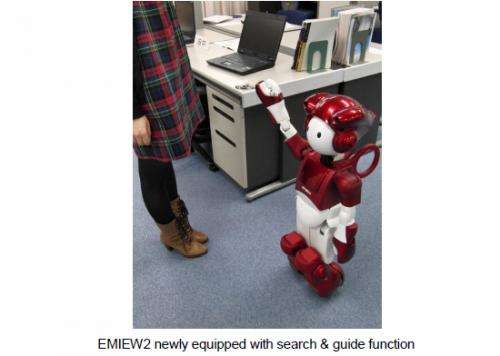Locate and guide function for the human symbiotic robot 'EMIEW2'

Hitachi announced the addition of a new feature to the human symbiotic robot, EMIEW2, where when asked the location of an object, is now able to smoothly guide the enquirer to the location of the object after identifying its location using network cameras installed within a facility as "eyes" to locate the object.
The human symbiotic robot, EMIEW2 developed by Hitachi in 2007, is a compact and light-weight robot capable of autonomous movement using a two-wheel mechanism moving at a speed of 6km/h, about the same pace as a human walking briskly, designed with view to providing a guidance service in offices and public facilities. Technology development was continued to enhance functionality, such as the features of being able to accurately recognize and respond to human voice against background noise as well as overcome cables and uneven floor heights for smooth movement, announced in 2010.
In order to provide even smoother service in offices and public facility guidance, a "locate and guide" function was newly developed. With this function, when EMIEW2 is asked to locate an object, it automatically "recognizes" the object using a database created from information on the Web, and identifies the location of the object using images captured by the multiple network cameras installed in the facility, and then quickly and smoothly guides the person to the location without dropping speed at corners or in narrow aisles. Details of the technology developed are as described below.
Web-based "object recognition" technology
"Object recognition" technology was developed whereby when EMIEW2 is presented with an object and asked its name, similar images are retrieved from a Web-based image database using high-speed similar image retrieval technology and the text data attached to the retrieved images is statistically analyzed to infer the name of the object, which it then returns as a reply.
1. Web-based image database: A database specifically for object recognition. The database stores images collected from the Web as image features that are high-dimensional numerical data which express image characteristics such as color distribution, shapes, etc., and link the image features to text data which were originally attached to the images on the Web.
2. High-speed similar image retrieval technology: Technology which retrieves visually similar images based on the image features which are aligned in the database for a high-speed search.
"Object search" technology using network cameras to locate objects
"Object search" technology was developed whereby when EMIEW2 is given a name of an object and asked to locate it, the object is matched against an Object-found database compiled from the images collected by multiple network cameras set up in the facility, and answers after identifying its location.
3. Object-found database: A database which records the position and time when the image was captured by the camera, and the name of the object inferred by "Object recognition technology" described in above.
"Model-predictive posture-control technology" to achieve smooth cornering while guiding persons
EMIEW2, with previous autonomous movement technology, "experienced" a strong change in centrifugal force when maneuvering a corner making it necessary to drop speed and to change directions before continuing movement. In order to cope smoothly with this change in centrifugal force and maneuver corners without dropping speed, "Model-predictive posture-control technology" was developed to calculate in real-time the optimal posture to counter the centrifugal force. By applying this technology in combination with the "Active suspension," a feature of EMIEW2, smooth movement without dropping speed was achieved even with sudden curves or in continuous curves along the route.
EMIEW2 is based on new developments on technology developed as part of the New Energy Development Organization (NEDO) commissioned project on the practical application of next-generation robots (prototype development support program) for EMIEW in 2005.
Details of the "Web-based object-recognition technology" will be presented at the 181st Computer vision and Image media Workshop of the Information Processing Society of Japan, to be held from 15th to 16th March 2012 at the Tokyo Institute of Technology, Tokyo, Japan.
Source: Hitachi




















